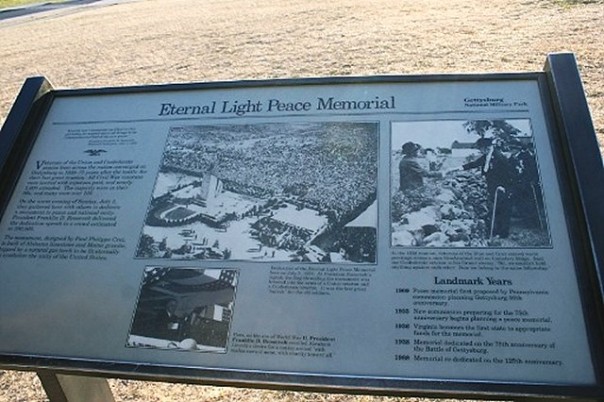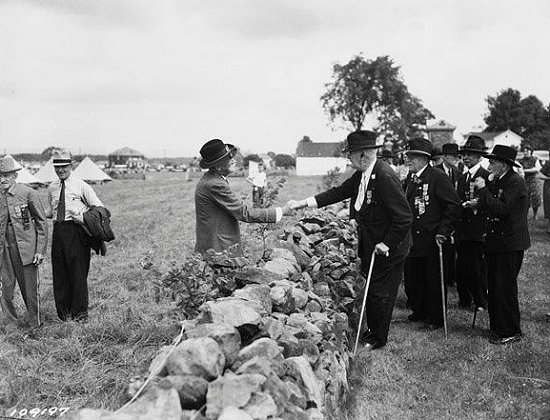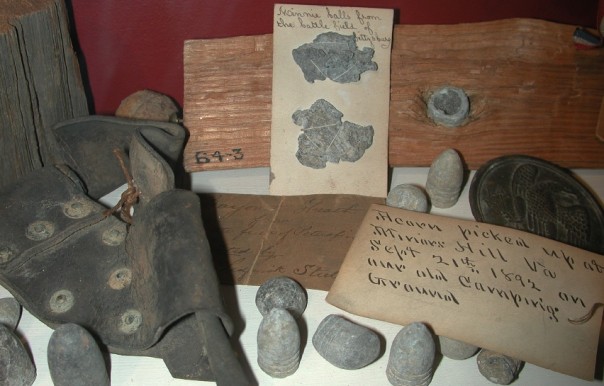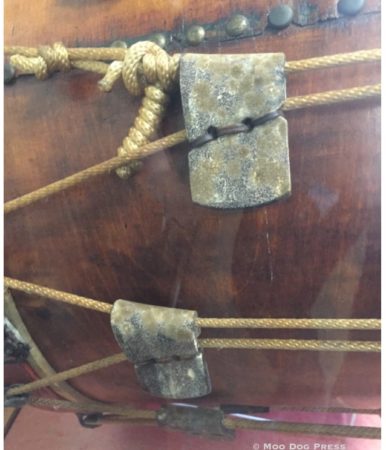Present: Gettysburg Walk Or Do, View An Arena Of Life
“It is not the critic who counts; not the man who points out how the strong man stumbles, or where the doer of deeds could have done them better. The credit belongs to the man who is actually in the arena, whose face is marred by dust and sweat and blood; who strives valiantly; who errs, who comes short again and again, because there is no effort without error and shortcoming; but who does actually strive to do the deeds; who knows great enthusiasms, the great devotions; who spends himself in a worthy cause; who at the best knows in the end the triumph of high achievement, and who at the worst, if he fails, at least fails while daring greatly, so that his place shall never be with those cold and timid souls who neither know victory nor defeat.” ― Theodore Roosevelt
A small framed excerpt placed on a side table near the office door, Cromwell, Connecticut. Publisher.
Yes. (How many went by and never stopped to read this?)
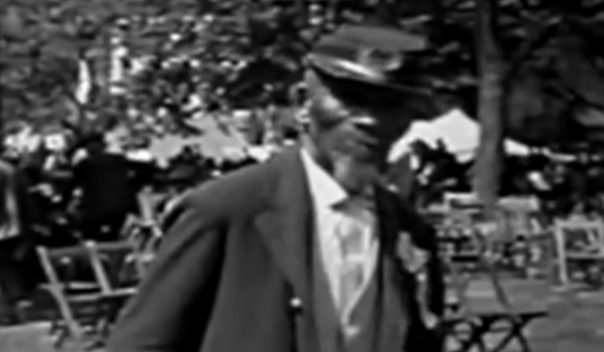
A veteran. Still from Battle of Gettysburg 75th anniversary (1938) Paramount & Universal Newsreels, linked to YouTube video. A technological bridge into the past and amazing glimpses into the event, which includes unveiling the Gettysburg Eternal Light Memorial with FDR.
Dance or sit on the chair on the sidelines and make comments what each is doing not perfectly. Never mind, let's focus on those who do, act, accomplish, try. Do, done, did.
History is people. Choices. Ignore all documented and written at your peril. Because reading provides insight into the now.
A conflict brews and threatens to rip the nation in two and must be resolved.
Oh it was July, and the weather was hot and sultry for three days of battle at the small crossroads town known as Gettysburg, Pennsylvania. Humans brawled back and forth across the open farm country of Pennsylvania in sweltering summer heat. Civilians, horses, dogs. Imagine the aromas.
By Independence Day, July 4th, it rained and Lee's troops (and the wounded) retreated across the Potomac River into Virginia.
There is nothing like paying a visit the place where the battle happened. Walk, learn. Think.
But next best (or before a trip there) is to watch the movie “Gettysburg” – especially to get the feel of the event (think of fighting in the heat, sanitation, no antibiotics.) A DVD with commentary (yes, older technology) adds interesting insights to the human drama as well as challenges in making the film, based on Michael Shaara's Pulitzer Prize-winning novel The Killer Angels. Okay, the facial hair and styling is a bit dated; ignore that. 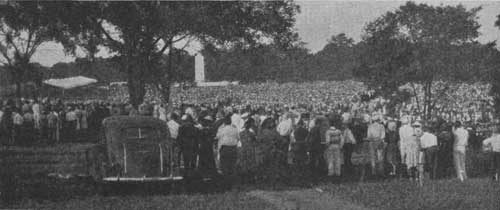
Above, a portion of the crowd, estimated at 250,000 people who were present on the occasion of the dedication of the Eternal Light Peace Memorial, July 3, 1938, in Gettysburg National Military Park. The dedicatory address was given by President Franklin D. Roosevelt in front of the Peace Memorial, which may be seen at the center background. The veterans pavilion is at the left. To view a short clip of Gettysburg battle survivors shaking hands across the stone wall at the Angle (and one giving a rebel yell), visit this link to YouTube.
A longer version is linked here. Amazing that early technology captured this chapter in American history.
“For every Southern boy 14 years old, not once but whenever he wants it is the instant when it is still not yet two o'clock on that July afternoon in 1863, the brigades are in position behind the rail fence, the guns are laid and ready in the woods and the furled flags are already loosened to break out and Pickett himself with his long oiled ringlets and his hat in one hand and his sword in the other looking up the hill waiting for Longstreet to give the word and it's all in the balance, it hasn't happened yet, it hasn't even begun yet, it not only hasn't begun yet but there is still time for it not to begin against that position and those circumstances . . .”
– William Faulkner
Mebbe. Or just wishful thinking to retain workers whose labor was “free” for those who embraced slavery, wanted it to continue. Not romantic. The rebels lost.
The brilliant Confederate General Thomas “Stonewall” Jackson was not present. Mistakenly shot by fire from his own men in the murk during the battle of the Wilderness just months before, Jackson was dead, at rest beneath the Virginia soil. Visit Lexington and New Market and consider the thoughts of battles and those who died. The human toll of the desire to retain slavery is at the core. Despite earlier beliefs, the more books read, the clearer it all is seen. Slaves and labor, not “free” and not right. It wasn't just people in South either who owned slaves. Travel, learn, read.
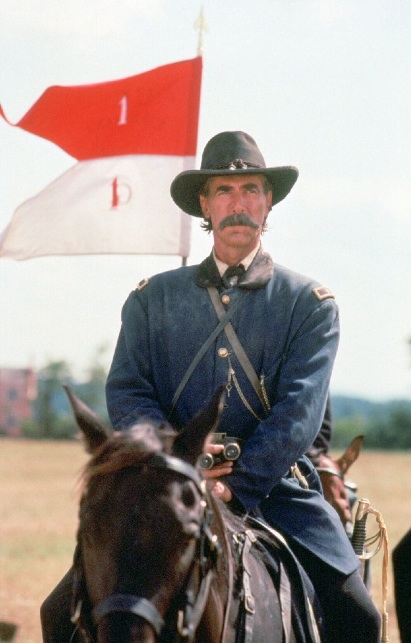 Soldiers from Texas were there at Gettysburg. Alabama, Georgia, Louisiana, Mississippi, South Carolina and Virginia. Connecticut, Indiana, Massachusetts, Michigan, Maine, New York, Pennsylvania and Wisconsin. And so many more. The war went on.
Soldiers from Texas were there at Gettysburg. Alabama, Georgia, Louisiana, Mississippi, South Carolina and Virginia. Connecticut, Indiana, Massachusetts, Michigan, Maine, New York, Pennsylvania and Wisconsin. And so many more. The war went on.
This year reading more about Vicksburg.
Now, some current events.
New mural of John Brown going up in Holyoke MA based on iconic 1847 daguerreotype of Brown made in Hartford by pioneering Black photographer Augustus Washington pic.twitter.com/KYqDMykoC6
— DFA New Haven (@DFANewHaven) June 29, 2023
Today’s the day! 🚲 CT e-bike rebate launches:https://t.co/9sdXLLPV68
Good for people & our 🌎 it offers low cost green transportation option to expand accessibility & decrease emissions. Proud to work on bill last year w/Rep. Lemar @SenatorCohenCT @RepKavrosDeGraw @CTDEEPNews pic.twitter.com/ljQ2FnHZ9W
— Kate Farrar (@kateforct) June 28, 2023
Indigenous people, they were here first. Water decision by others in black robes? Seems wrong.
Many tribes hold senior priority water rights, meaning they are legally guaranteed water over other users. Read our analysis, in partnership w/ @propublica, about the recent #SCOTUS ruling https://t.co/OXjq4ghBFE
— High Country News (@highcountrynews) June 27, 2023
And one piercingly on target.
The famous Scorsese ad is funny because it’s true.#writing pic.twitter.com/OTBIR6BHAp
— Jonny Geller (@JonnyGeller) June 28, 2023
From Meriden, CT, a sign seen and some research.
“The Loar Group is assembling a business platform through a strategic global alliance of companies specializing in the design and manufacture of Aerospace and Defense components.”
Also see CEO and founder, team: https://t.co/m69ulKSAom
— Moo Dog Press (@MooDogPress) June 29, 2023
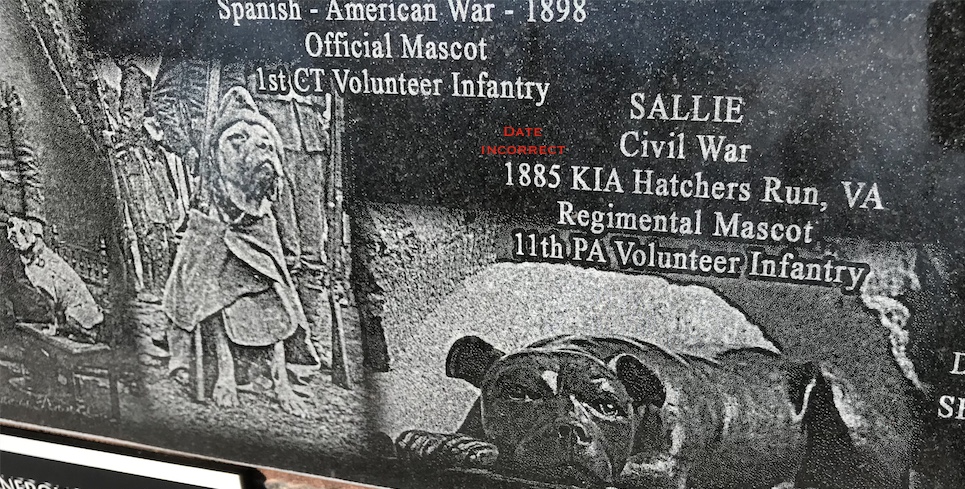
Stubby to far left, and Sallie at Vets Park Memorial, Middletown, CT. Sallie is memorialized at Gettysburg National Military Park.
Note: Return to Deep River for another story. And by the way, the muster there is unforgettable. So much to see, learn, do. Insatiable curiosity, a writing life. This story has been updated and contains a portion brought forward from the archives.

